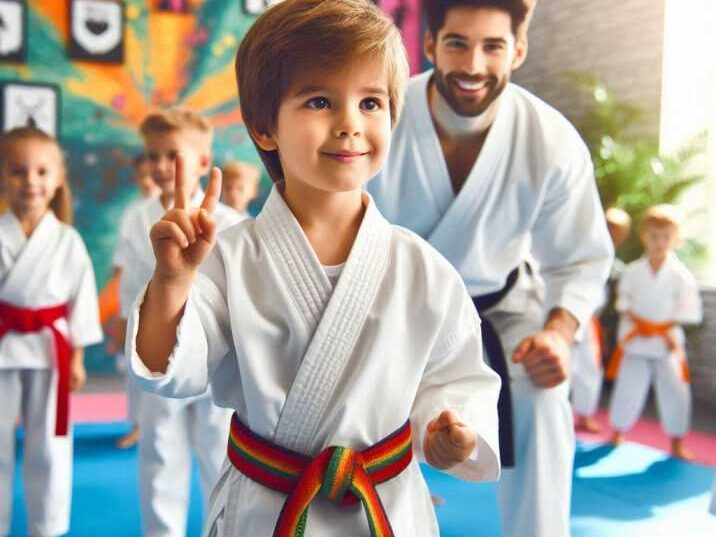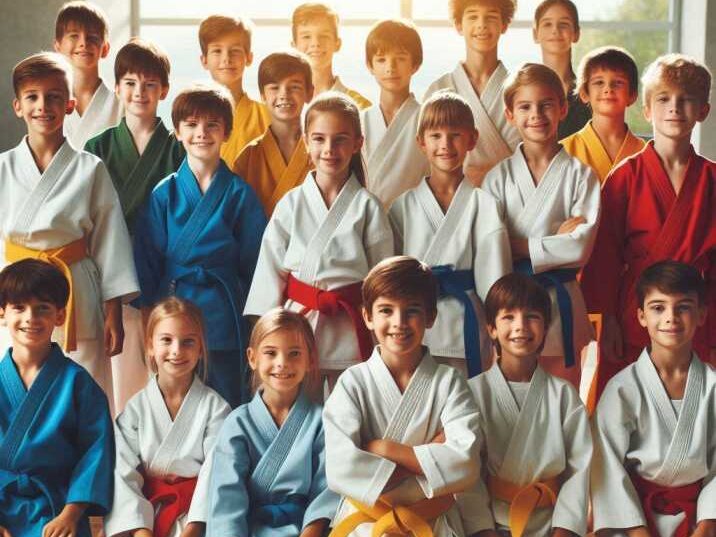Introduction
Table of Contents
Parents today want more than just screen-free activities for their kids. They want programs that build confidence, discipline, and real-life skills. Martial arts check all those boxes.
When you think of martial arts, you might picture action movies. But for kids, it is much more than kicks and punches. It is about respect, focus, and learning how to stay safe.
In this guide, we will walk through the top 7 martial arts for kids. You will see what each one is, how it helps children grow, what risks to consider, and simple tips to keep training safe. By the end, you will know which martial art fits your child best.
1. Karate
What It Is
Karate began in Okinawa, Japan, as a system of self-defense. It focuses on strikes like punches, kicks, and open-hand techniques. Kids also practice forms called “kata,” which are structured movements that build discipline and memory. Sparring with partners helps them apply what they learn in real-life scenarios.

Benefits for Kids
Builds focus through repetitive practice
Karate requires children to repeat techniques many times until they master them. This repetition teaches patience and focus, skills that transfer to school and everyday life. Over time, kids learn to concentrate deeply on one task without distraction.
Teaches respect for teachers and classmates
Karate emphasizes bowing, listening, and following instructions. Kids learn to respect their instructors and treat classmates with kindness. This respect often extends beyond the dojo, shaping how they interact at home and in school.
Improves coordination and body control
The structured movements in karate help children understand how their bodies work. They develop balance, timing, and strength through practice. These skills are especially helpful for younger kids who are still improving motor skills.
Builds self-confidence after earning new belts
Karate uses a belt ranking system to mark progress. Each belt earned gives kids a sense of achievement and motivation to keep going. This steady progress builds confidence and shows them that effort leads to success.
Risks or Concerns
Sparring can cause bumps or bruises if not done with proper gear
When children spar, they may get minor injuries like bruises or scratches. Without proper protective gear, these risks increase. The right safety equipment helps reduce harm and keeps kids comfortable while learning.
Some schools may push competition too early
Certain karate schools focus heavily on tournaments and winning medals. For young children, this can add unnecessary pressure. Parents should look for programs that focus on learning and personal growth, not just competition.
Safety Tips
Make sure your child wears protective gear during sparring
Gear like gloves, helmets, mouthguards, and shin guards protect kids from accidental injuries. Having the right equipment makes sparring safer and builds confidence.
Ask the instructor about non-contact or light-contact options for beginners
Many schools offer controlled sparring with little or no contact. This allows kids to practice safely while building skills. Beginners especially benefit from this gentler approach.
Choose a school that values discipline over trophies
A good karate school teaches respect, self-control, and personal improvement. Parents should look for programs that reward effort and discipline, not just winning tournaments.
2. Taekwondo
What It Is
Taekwondo is a martial art from Korea, known worldwide for its powerful, high kicks and fast movements. It blends sport and tradition, focusing on both self-defense and competition. Because of its popularity, Taekwondo is an official Olympic sport. Kids often enjoy it because of its dynamic style and exciting energy.
Benefits for Kids
Improves flexibility and balance
Taekwondo training includes many kicks that stretch the legs and strengthen stabilizing muscles. Over time, kids become more flexible, which helps prevent injuries in sports and daily activities. They also gain better balance, which improves overall coordination.
Encourages goal setting through belt testing
The belt system in Taekwondo motivates kids to work toward clear milestones. Each new belt requires practice, discipline, and testing. Achieving these goals gives children a sense of progress and teaches them the value of hard work.
Teaches discipline and focus
Classes are structured with rules, respect, and routines. Kids must listen carefully to instructions, practice with patience, and respect their instructors. This discipline improves their ability to concentrate in school and at home.
Builds strong legs and core strength
Because Taekwondo emphasizes kicks, children develop powerful leg muscles. The constant kicking, jumping, and balancing also strengthen their core. This improves posture and overall physical fitness.
Risks or Concerns
Heavy focus on kicks may strain knees or hips
The repeated high kicks can put stress on joints if children don’t warm up properly. Younger kids or those with weak flexibility may feel strain in their knees and hips. Proper stretching and guidance reduce these risks.
Competitive schools may stress kids who just want fun
Some schools emphasize winning tournaments, which can create pressure. Not every child enjoys competition, and this focus may discourage them. Parents should choose programs that match their child’s goals and personality.
Safety Tips
Warm-up and stretching should be part of every class
Proper warm-ups prepare the muscles and joints for movement. Stretching before and after training reduces the chance of injury. Parents should check if the school follows these practices.
Limit the number of tournaments your child joins
Competitions can be fun but should not dominate training. Too many tournaments may create stress or take away from learning. Choose schools that balance training with healthy competition.
Make sure the school has certified instructors
Qualified instructors know how to teach safely and effectively. They adjust training for age and ability, keeping children safe while helping them improve. Parents should always confirm certifications before enrolling.
3. Judo
What It Is
Judo means “gentle way” in Japanese. Unlike striking martial arts, it focuses on throws, pins, and grappling instead of punches or kicks. Kids learn how to use balance, timing, and leverage to control an opponent. Judo is also an Olympic sport, which adds recognition and structure to its practice.
Benefits for Kids
Teaches balance and body control
Judo techniques require precise movements to stay stable while throwing or resisting an opponent. Kids learn how to shift weight, stand firm, and move smoothly. This improves coordination, posture, and overall physical control.
Builds problem-solving skills through strategy
Each match is like a puzzle, as kids must find the best way to counter or throw their partner. Judo teaches them to think ahead, adapt quickly, and stay calm under pressure. These skills transfer to problem-solving in school and life.
Teaches respect for opponents and teamwork
Judo has a strong tradition of bowing and showing respect before and after practice. Kids must rely on training partners to practice safely, which teaches cooperation and mutual trust. This teamwork builds friendships and character.
Builds physical strength and endurance
The throwing, grappling, and drills in Judo develop strong muscles, especially in the arms, legs, and core. Kids also build stamina from regular practice and sparring. This makes Judo a full-body workout that keeps them active and healthy.
Risks or Concerns
Falling the wrong way can cause minor injuries
Since Judo involves throws, improper falling can lead to bruises or sprains. Kids need to learn safe landing skills first to reduce this risk. Once mastered, falling becomes much safer.
Rough training without supervision can be unsafe
If sparring gets too intense or instructors don’t monitor closely, kids may get hurt. Judo should always be practiced under trained supervision with clear safety rules.
Safety Tips
Look for schools that teach safe falling techniques first
A good Judo school always starts with ukemi, the art of safe falling. This ensures kids protect their heads, backs, and arms when thrown. It’s the most important foundation of Judo safety.
Check if mats are thick and in good condition
Thick, high-quality mats absorb impact from falls and throws. Worn-out or thin mats increase injury risks. Parents should always check the training area before enrolling their child.
Limit hard sparring until your child has good basics
Beginners should focus on learning techniques and safe movements before doing full sparring. Controlled, light training helps kids gain confidence and reduces the chance of accidents.
4. Brazilian Jiu-Jitsu (BJJ)
What It Is
Brazilian Jiu-Jitsu, or BJJ, is a martial art that focuses on ground fighting and grappling. Instead of punches and kicks, kids learn holds, sweeps, and submissions to control an opponent. The idea is to use technique and leverage rather than strength. This makes it especially useful for kids of all sizes.
Benefits for Kids
Practical self-defense, even against bigger opponents
BJJ teaches children how to defend themselves by using leverage and technique. This means a smaller child can control or escape from someone larger. It gives them confidence in real-world situations.
Builds patience and problem-solving
BJJ matches often feel like a chess game, where kids must think about their next move. They learn patience as they set up techniques step by step. This develops problem-solving skills both on and off the mat.
Teaches kids not to panic under pressure
When pinned or held down, kids learn to stay calm and think instead of panicking. Instructors teach breathing and controlled movements. This helps children handle stressful situations with a clear mind.
Great for kids who are smaller or less aggressive
Because BJJ doesn’t rely on strength or striking, it suits kids who may be shy or physically smaller. They learn they can succeed through smart technique, which boosts confidence.
Risks or Concerns
Joint locks, if taught too early, can be risky
Advanced submissions like arm locks or leg locks put pressure on joints. If kids learn them too young, they may misuse them or get hurt. Reputable schools delay teaching these until children are ready.
Rolling (sparring) can feel overwhelming for shy kids
Live sparring, known as rolling, can feel intense at first. Shy or anxious children may feel uncomfortable being in close contact with others. Supportive instructors should ease kids into this gradually.
Safety Tips
Choose a school with a separate kids’ program
Not all schools adapt BJJ for children. Parents should find programs designed for kids, with age-appropriate drills and techniques. This ensures safety and enjoyment.
Instructors should not allow submissions for very young children
Good instructors teach control and positioning first. They delay submissions until kids are older and understand safety. This prevents unnecessary injuries.
Encourage tapping out early to avoid injuries
In BJJ, “tapping out” signals surrender in a match. Kids should learn to tap quickly when uncomfortable. This builds safety awareness and prevents injuries during sparring.
5. Kung Fu
What It Is?
Kung Fu is one of the oldest martial arts, developed in China. It includes many different styles, some modeled after animal movements like tiger, crane, or snake. Training often involves fluid forms, self-defense techniques, and conditioning exercises. Kids enjoy its variety and cultural depth.
Benefits for Kids
Teaches discipline and patience through forms
Kung Fu requires kids to practice forms repeatedly until they get the details right. This builds patience and attention to detail. The discipline they develop helps them stay focused in other parts of life.
Builds flexibility, strength, and stamina
Kung Fu includes stretching, stances, and fast movements that challenge the whole body. Kids become stronger, more flexible, and build endurance over time. This makes them fitter and healthier overall.
Connects kids to cultural history and traditions
Kung Fu classes often include lessons about Chinese history, philosophy, and values. Kids gain respect for another culture while learning martial skills. This cultural element makes training more meaningful.
Encourages mindfulness and self-control
Many Kung Fu styles teach breathing, meditation, and awareness. Kids learn to control emotions and stay calm under pressure. This mindfulness helps in school, at home, and in daily life.
Risks or Concerns
Complex moves may frustrate very young kids
Kung Fu often has complicated stances and forms that require patience. Younger children may struggle with the complexity and lose motivation. Parents should consider age before enrolling.
Some schools may not focus enough on safety
Because Kung Fu varies widely in styles and schools, some instructors may not teach safety as a priority. Without structure, kids may risk injury. Parents need to check the program carefully.
Safety Tips
Look for beginner-friendly classes
A good Kung Fu school introduces simple movements before advanced forms. This keeps kids motivated and safe. Parents should ask if classes are adapted for young learners.
Check if instructors adjust lessons by age
Not all moves are suited for every age group. A skilled instructor should modify lessons to match the child’s ability. This ensures steady progress without frustration.
Make sure kids warm up properly before training
Warm-ups prepare muscles for fast movements and prevent injuries. Parents should confirm that classes include stretching and conditioning at the start.
6. Aikido
What It Is
Aikido is a Japanese martial art that teaches kids how to defend themselves without causing harm. Instead of punches or kicks, it uses throws, pins, and joint locks to redirect an opponent’s energy. The goal is to stay safe while keeping others safe too. Its peaceful philosophy makes it unique among martial arts.
Benefits for Kids
Teaches non-violence and conflict resolution
Aikido focuses on defense rather than attack. Kids learn how to avoid fights and calm situations without aggression. This makes it a good choice for parents who want their children to learn peaceful conflict resolution.
Improves balance and awareness
Movements in Aikido require kids to stay centered and aware of their surroundings. They develop better posture, stability, and body control. This balance also improves performance in sports and daily activities.
Encourages calm reactions under stress
Aikido training shows children how to stay composed when grabbed or pushed. Instead of panicking, they learn to breathe and respond with control. This ability helps them handle stressful moments in school or at home.
Builds confidence through gentle techniques
Kids gain confidence by learning they can defend themselves without hurting others. Gentle techniques help shy or cautious children feel capable and strong. Over time, this builds self-assurance in everyday life.
Risks or Concerns
Techniques can be tricky for very young children
Aikido movements involve coordination and timing, which may be difficult for kids under 7. Younger children may struggle to follow the patterns or get frustrated. Starting at the right age makes training smoother.
Too much twisting may strain joints
Some Aikido techniques involve wrist or arm locks that require flexibility. If done incorrectly, these can strain young joints. Proper instruction and age-appropriate adjustments reduce this risk.
Safety Tips
Make sure instructors adapt techniques for kids
A good Aikido school modifies lessons for children, keeping moves simple and safe. Parents should ask how the instructor teaches different age groups.
Avoid joint locks until children are older
Joint locks should only be introduced when kids understand control and safety. Delaying these moves protects their growing bodies.
Start with classes that focus on movement, not advanced techniques
Beginner classes should emphasize footwork, balance, and safe falls. This foundation prepares kids for more advanced techniques later.
7. Mixed Martial Arts (MMA for Kids)
What It Is
MMA is a modern martial art that combines skills from karate, boxing, wrestling, and Brazilian Jiu-Jitsu. For kids, MMA programs are usually focused on fitness and light-contact training, not full competition. It gives children exposure to multiple martial arts in one program.
Benefits for Kids
Gives kids well-rounded skills
Because MMA blends several styles, children learn striking, grappling, and self-defense all in one place. This makes their training versatile and practical. They can adapt to many different situations.
Builds strength, endurance, and agility
MMA workouts are intense, with drills that challenge every part of the body. Kids gain muscle, stamina, and quick reflexes. This improves overall athletic performance.
Teaches real-world self-defense
By learning multiple disciplines, children get practical self-defense skills. They know how to defend themselves standing or on the ground. This gives them confidence in real-life scenarios.
Boosts confidence and resilience
MMA training often pushes kids to work hard and face challenges. Overcoming tough workouts and new skills builds mental toughness. This resilience carries over into school and personal life.
Risks or Concerns
Can seem too rough if the school is competition-heavy
Some MMA schools focus on fighting and tournaments. This can intimidate kids who just want fitness and fun. Parents should choose a school with a family-friendly environment.
Parents may worry about safety due to MMA’s adult image
Because adult MMA is known for cage fights, parents sometimes worry about kids’ safety. However, children’s MMA programs are designed to be much safer. It’s important to check the program’s focus.
Safety Tips
Look for programs designed specifically for kids
Not every MMA school is child-friendly. Parents should make sure the program is tailored to kids, with age-appropriate drills and no dangerous techniques.
Ask if striking is controlled and light-contact
For kids, strikes should be light and carefully monitored. Full-contact sparring is not necessary at beginner levels.
Make sure protective gear is always used
Headgear, gloves, mouthguards, and shin guards are essential. Proper equipment greatly reduces the risk of injury.
Table: Martial Arts at a Glance
| Martial Art | Best For | Key Benefits | Main Concern |
|---|---|---|---|
| Karate | Ages 5+ | Discipline, respect, coordination | Sparring injuries |
| Taekwondo | Ages 5+ | Flexibility, goal setting | Knee/hip strain |
| Judo | Ages 6+ | Balance, strength, problem-solving | Falls |
| Brazilian Jiu-Jitsu | Ages 6+ | Self-defense, patience, resilience | Joint locks |
| Kung Fu | Ages 7+ | Flexibility, tradition, mindfulness | Complex forms |
| Aikido | Ages 8+ | Calmness, awareness, non-violence | Joint strain |
| MMA for Kids | Ages 8+ | All-around skills, fitness | Competition pressure |

Conclusion
Martial arts are more than sports. They shape character, build focus, and help kids grow stronger inside and out. Each martial art offers unique benefits. Some are fast and dynamic like Taekwondo. Others are calm and controlled like Aikido.
The best choice depends on your child’s age, personality, and goals. Try a free trial class before making a decision. With the right school, your child will not just learn martial arts. They will build skills that last a lifetime.
FAQs
1. What is the best age to start martial arts?
Most kids can start around age 5 or 6. Some programs accept younger children with simple drills.
2. Which martial art is safest for kids?
Aikido and BJJ are generally safe because they focus on control, not striking. Safety depends more on the school than the style.
3. How often should kids train?
Two to three classes per week is ideal. It gives progress without overwhelming kids.
4. Do martial arts make kids aggressive?
No. Martial arts often teach respect, discipline, and self-control. Kids usually become calmer and more focused.
5. How do I choose the right martial arts school?
Visit the school. Watch a class. Check if the instructors are certified, the environment is safe, and the kids look engaged and happy.


